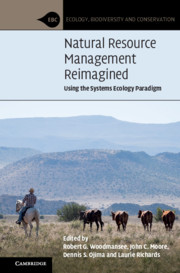Book contents
- Natural Resource Management Reimagined
- Ecology, Biodiversity and Conservation
- Natural Resource Management Reimagined
- Copyright page
- Contents
- Contributors
- Preface
- 1 The Systems Ecology Paradigm
- 2 Environmental and Natural Resource Challenges in the Twenty-First Century
- 3 Evolution of Ecosystem Science to Advance Science and Society in the Twenty-First Century
- 4 Five Decades of Modeling Supporting the Systems Ecology Paradigm
- 5 Advances in Technology Supporting the Systems Ecology Paradigm
- 6 Emergence of Cross-Scale Structural and Functional Processes in Ecosystem Science
- 7 Evolution of the Systems Ecology Paradigm in Managing Ecosystems
- 8 Land/Atmosphere/Water Interactions
- 9 Humans in Ecosystems
- 10 A Systems Ecology Approach for Community-Based Decision Making
- 11 Environmental Literacy
- 12 Organizational and Administrative Challenges and Innovations
- 13 Where to From Here? Unraveling Wicked Problems
- Index
- References
1 - The Systems Ecology Paradigm
Published online by Cambridge University Press: 25 February 2021
- Natural Resource Management Reimagined
- Ecology, Biodiversity and Conservation
- Natural Resource Management Reimagined
- Copyright page
- Contents
- Contributors
- Preface
- 1 The Systems Ecology Paradigm
- 2 Environmental and Natural Resource Challenges in the Twenty-First Century
- 3 Evolution of Ecosystem Science to Advance Science and Society in the Twenty-First Century
- 4 Five Decades of Modeling Supporting the Systems Ecology Paradigm
- 5 Advances in Technology Supporting the Systems Ecology Paradigm
- 6 Emergence of Cross-Scale Structural and Functional Processes in Ecosystem Science
- 7 Evolution of the Systems Ecology Paradigm in Managing Ecosystems
- 8 Land/Atmosphere/Water Interactions
- 9 Humans in Ecosystems
- 10 A Systems Ecology Approach for Community-Based Decision Making
- 11 Environmental Literacy
- 12 Organizational and Administrative Challenges and Innovations
- 13 Where to From Here? Unraveling Wicked Problems
- Index
- References
Summary
The systems ecology paradigm (SEP) is presented as the right science and analytical approach at the right time for resolving many of the Earth’s natural resource, environmental, and societal challenges. SEP embodies two major parts. One, the systems ecology approach, which is the holistic, systems thinking perspective and methodology developed for the rigorous study of ecosystems, including humans. Two, the use of ecosystem science, the vast body of scientific knowledge, much of which has been assembled using the ecosystem and systems ecology approaches. The fundamental philosophy, evolution, and application of the SEP are defined in this chapter. The organizing principles of the SEP include: many problems are complex and complicated and may have multiple causes; precise definitions of problems and their spatial, temporal, and organizational hierarchical scales are critical; collaborative decision making including scientists, technical and administrative staff members, and essential stakeholders is essential; transparent, honest, and effective communication is required; globalization of collaboration within interdisciplinary networks has been a hallmark of the paradigm; and integration of simulation modeling, field and laboratory studies has proven indispensable for many scientific breakthroughs. A call for integration of transdisciplinary science, policy making, and management is presented.
Keywords
- Type
- Chapter
- Information
- Natural Resource Management ReimaginedUsing the Systems Ecology Paradigm, pp. 1 - 35Publisher: Cambridge University PressPrint publication year: 2021
References
- 1
- Cited by



